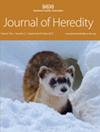A draft reference genome assembly of California Pipevine, Aristolochia californica Torr
IF 3
2区 生物学
Q2 EVOLUTIONARY BIOLOGY
引用次数: 0
Abstract
The California Pipevine, Aristolochia californica Torr., is the only endemic California species within the cosmopolitan birthwort family Aristolochiaceae. It occurs as an understory vine in riparian and chaparral areas and in forest edges and windrows. The geographic range of this plant species almost entirely overlaps with that of its major specialized herbivore, the California Pipevine Swallowtail Butterfly Battus philenor hirsuta. While this species pair is a useful, ecologically well-understood system to study co-evolution, until recently, genomic resources for both have been lacking. Here, we report a new, chromosome-level assembly of A. californica as part of the California Conservation Genomics Project (CCGP). Following the sequencing and assembly strategy of the CCGP, we used Pacific Biosciences HiFi long reads and Hi-C chromatin proximity sequencing technology to produce a de novo assembled genome. Our genome assembly, the first for any species in the genus, contains 531 scaffolds spanning 661 megabase (Mb) pairs, with a contig N50 of 6.53 Mb, a scaffold N50 of 42.2 Mb, and BUSCO complete score of 98%. In combination with the recently published B. philenor hirsuta reference genome assembly, the A. californica reference genome assembly will be a powerful tool for studying co-evolution in a rapidly changing California landscape.加利福尼亚琵琶藤(Aristolochia californica Torr)参考基因组组装草案
加利福尼亚管藤(Aristolochia californica Torr.)是马兜铃科(Aristolochiaceae)世界性胎生植物中唯一的加利福尼亚特有物种。它作为林下藤本植物出现在河岸和灌丛地区以及森林边缘和风口处。该植物物种的地理分布范围几乎完全与其主要的专门食草动物加利福尼亚琵琶藤燕尾蝶 Battus philenor hirsuta 重叠。虽然这对物种是研究共同进化的一个有用的、生态学上很好理解的系统,但直到最近,两者的基因组资源一直缺乏。在此,我们报告了作为加利福尼亚保护基因组学项目(CCGP)一部分的新的加利福尼亚蝶染色体组组装结果。按照 CCGP 的测序和组装策略,我们使用太平洋生物科学公司的 HiFi 长读数和 Hi-C 染色质近似测序技术,重新组装了基因组。我们的基因组组装是该属任何物种的首次组装,包含 531 个支架,跨度为 661 兆位元组(Mb)对,等位基因 N50 为 6.53 Mb,支架 N50 为 42.2 Mb,BUSCO 完整得分率为 98%。结合最近发表的 B. philenor hirsuta 参考基因组组装,A. californica 参考基因组组装将成为研究快速变化的加利福尼亚景观中共同进化的有力工具。
本文章由计算机程序翻译,如有差异,请以英文原文为准。
求助全文
约1分钟内获得全文
求助全文
来源期刊

Journal of Heredity
生物-遗传学
CiteScore
5.20
自引率
6.50%
发文量
63
审稿时长
6-12 weeks
期刊介绍:
Over the last 100 years, the Journal of Heredity has established and maintained a tradition of scholarly excellence in the publication of genetics research. Virtually every major figure in the field has contributed to the journal.
Established in 1903, Journal of Heredity covers organismal genetics across a wide range of disciplines and taxa. Articles include such rapidly advancing fields as conservation genetics of endangered species, population structure and phylogeography, molecular evolution and speciation, molecular genetics of disease resistance in plants and animals, genetic biodiversity and relevant computer programs.
 求助内容:
求助内容: 应助结果提醒方式:
应助结果提醒方式:


